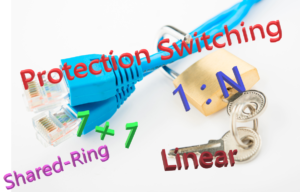What is Bidirectional Protection Switching (and How is it Different from Unidirectional Protection Switching)?
The Definition of Bidirectional Protection Switching
ITU-T G.780 defines Bidirectional Protection Switching as follows:
A protection switching architecture in which, for a unidirectional failure (i.e., a failure affecting only one direction of transmission), both directions (of the “trail,” “subnetwork connection,” etc.), including the affected direction and the unaffected direction, are switched to protection.
What does All That Mean?
I will explain all this through three (3) illustrations/cases.
- The Normal/No Defect Case
- The Defect/Bidirectional Protection Switching Case and
- The Defect/Unidirectional Protection Switching Case
The Normal/No Defect Case
Figure 1 illustrates a “Normal” (e.g., No Defect) condition.
This illustration shows two network elements transmitting and receiving traffic to and from each other.
We will call one of these network elements Network Element West and the other network element Network Element East.

Figure 1, Illustration of two Network Elements exchanging traffic during Normal/No-defect conditions.
Figure 1 also shows Protection Switching support for the traffic flow between these two Network Elements.
This figure shows a Bidirectional Working Transport Entity between these two Network Elements.
The figure also shows that there is a Bidirectional Protection Transport Entity between these two Network Elements, as well.
In this case, neither Network Element declares any defect within the Working Transport Entity, and Good/Normal Bi-directional traffic flows between these two Network Elements.
Finally, this figure also shows that all the traffic flows through the Working Transport Entities and that none of the traffic flows through the Protect Transport Entities.
Next, we will consider what happens whenever one Network Elements declares a service-affecting defect within the Working Transport Entity.
Bidirectional Protection Switching Case
Figure 2 presents an illustration of a Defect condition.
In this case, some impairment exists within the West-to-East Working Transport connection, and Network Element East is declaring some service-affecting defect with this traffic signal.

Figure 2, Illustration of Bidirectional Protection Switching – in response to a Service-Affecting Defect in one direction of traffic
Since this defect exists within the Working Transport connection (in the West-to-East direction), this protection switching scheme will route all West-to-East traffic through the Protect Transport Entity instead.
Yet, this protection scheme does not stop there. It will also route all East-to-West traffic through the Protect Transport entity.
In other words, if we detect a defect within the Working Transport Entity (at all), we will route traffic for BOTH directions from the Working Transport entity to the Protect Transport entity.
We call this particular protection scheme Bidirectional Protection Switching because, in this case, we are performing protection switching in BOTH directions, even if we only declare a service-affecting defect in one direction.
NOTE: Since we perform protection switching in BOTH directions (for bidirectional protection switching), this kind of protection scheme requires that the protection group uses an APS or PCC (Protection Communications Channel).
Both ends of the protection group will need to communicate and coordinate with each other during protection switching events.
We will clarify the difference between Bidirectional and Unidirectional Protection Switching by showing the Unidirectional Protection Switching Case.
Unidirectional Protection Switching Case
Figure 3 presents another illustration of a Defect condition.
In this case, there is (once again) some impairment that exists within the West-to-East Working transport connection, and Network Element East is declaring some service-affecting defect with this traffic signal.

Figure 3, Illustration of Unidirectional Protection Switching – responds to a Service-Affecting Defect in one direction on traffic.
Since this defect exists within the Working Transport Entity, this protection scheme will route all West-to-East traffic through the Protect Transport entity.
Yet, in contrast to the Bidirectional Protection Switching scheme, it will continue to route all East-to-West traffic through the Working Transport entity; since there are no defects in that particular direction.
In other words, the Unidirectional Protection Switching scheme only routes the traffic directions (the Network Element has determined to be defective) through the Protect Transport Entity.
If it detects no defects within a given Working Transport entity (in the other direction), it will continue to route that traffic through the Working Transport entity.
We call this particular protection scheme Unidirectional Protection Switching because, in this case, we are performing protection switching in ONE direction if we only detect a service-affecting defect in ONE direction.
Please see the Unidirectional Protection Switching post for more detailed information on this protection switching scheme.
Summary
In summary, the main difference between Unidirectional and Bidirectional Protection switching is as follows.
For Bidirectional Protection Switching, if the Network Elements declare a service-affecting defect in ONLY one direction (of traffic), the protection scheme will still switch BOTH directions of traffic from the Working to the Protect Transport entity.
In the case of Unidirectional Protection Switching, if the Network Elements declare a service-affect defect in ONLY one direction (of traffic), then the protection scheme will only switch the defective direction from the Working Transport entity to the Protect Transport entity.
The other (non-defective) direction of traffic will continue to use the Working Transport Entity.
Has Inflation got You Down? With Our Pricing Special, You Can Beat Inflation and Become an Expert on OTN!! Click on the Banner Below to Learn More!!
Discounts Available for a Short Time!!!
Click on the Image Below to see more Protection-Switching related content on this Blog:


